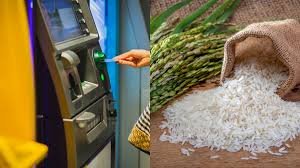Odisha Launches India’s First Rice ATM
Introduction to India’s First Rice ATM
In a pioneering move, the state of Odisha has introduced India’s first-ever rice ATM. This innovative initiative, launched by the Odisha government, aims to streamline the distribution of subsidized rice to the state’s beneficiaries. This rice ATM is designed to automate the process, ensuring efficient and transparent delivery of rice to eligible citizens under the Public Distribution System (PDS).
Purpose and Functionality
The rice ATM operates similarly to conventional ATMs but is tailored for dispensing rice. Beneficiaries can use their ration cards to access the ATM and withdraw their entitled amount of rice. This system reduces manual intervention and minimizes the potential for errors and corruption. It’s an effort to modernize the public distribution system and address issues related to rationing and distribution.
Impact on Beneficiaries
The introduction of the rice ATM is expected to significantly impact the beneficiaries by simplifying the process of receiving their subsidized rice. It aims to reduce long queues and wait times at ration shops, enhancing convenience and efficiency. The system also introduces a level of accountability and transparency, as each transaction is recorded electronically.
Government’s Vision and Future Plans
The Odisha government’s initiative aligns with its broader vision of leveraging technology to improve public service delivery. If successful, the model may be replicated in other states to enhance the efficiency of the PDS across India. The government is also exploring the integration of other essential commodities into the ATM system in the future.

Why This News is Important
Revolutionizing Public Distribution
The launch of India’s first rice ATM marks a significant shift in the public distribution system (PDS). By automating the process of distributing rice, the initiative promises to enhance efficiency and transparency. This is crucial in a country where the PDS often faces challenges such as corruption and inefficiency.
Addressing Systemic Issues
Traditional ration distribution methods have been plagued by problems like delays, mismanagement, and long queues. The rice ATM addresses these issues by providing a more streamlined and user-friendly alternative. This modernization effort can serve as a model for other states and countries looking to improve their food distribution systems.
Technological Integration in Governance
The introduction of the rice ATM highlights the growing trend of integrating technology into governance. It reflects a broader move towards digital solutions to enhance public service delivery. This initiative demonstrates how technology can be harnessed to improve administrative processes and service efficiency.
Potential for Expansion
If successful, the rice ATM could set a precedent for the distribution of other essential commodities. The model’s success in Odisha may lead to its adoption in other states, contributing to a more efficient and transparent PDS nationwide. This potential for expansion underscores the importance of the initiative.
Enhancing Beneficiary Experience
By reducing manual intervention and streamlining the distribution process, the rice ATM significantly enhances the beneficiary experience. It ensures that the distribution of subsidized rice is more reliable and accessible, thereby improving the quality of life for many individuals.
Historical Context
Evolution of the Public Distribution System
The Public Distribution System (PDS) in India has undergone numerous changes since its inception. Initially designed to provide food security to the needy, the system has faced various challenges over the decades. Issues such as inefficiency, corruption, and supply chain problems have been prevalent.
Technological Advancements in PDS
In recent years, there has been a push towards modernizing the PDS through technology. Initiatives like digital ration cards, e-PDS, and now the rice ATM reflect a broader trend of incorporating technological solutions to address systemic issues. The evolution of the PDS is part of a larger effort to enhance governance and service delivery in India.
Key Takeaways from Odisha Launches India’s First Rice ATM
| Serial Number | Key Takeaway |
|---|---|
| 1 | Odisha has introduced India’s first rice ATM to automate rice distribution. |
| 2 | The rice ATM aims to enhance efficiency and transparency in the Public Distribution System (PDS). |
| 3 | Beneficiaries can use their ration cards to access the ATM and withdraw their entitled rice. |
| 4 | The initiative reflects a broader trend of integrating technology into public service delivery. |
| 5 | The success of the rice ATM in Odisha could lead to its adoption in other states and for other commodities. |
Important FAQs for Students from this News
1. What is the purpose of the rice ATM introduced in Odisha?
The rice ATM aims to automate the distribution of subsidized rice to beneficiaries under the Public Distribution System (PDS), improving efficiency and transparency in the distribution process.
2. How does the rice ATM operate?
The rice ATM functions similarly to traditional ATMs but is designed to dispense rice. Beneficiaries use their ration cards to withdraw their allocated amount of rice.
3. What are the benefits of using a rice ATM?
The rice ATM provides several benefits, including reduced wait times, minimized manual intervention, improved transparency, and a more efficient distribution process.
4. Is the rice ATM initiative limited to Odisha?
Currently, the rice ATM initiative is implemented in Odisha. However, if successful, it may serve as a model for other states and could potentially be expanded to include other essential commodities.
5. How does the rice ATM fit into the broader context of public distribution system reforms?
The rice ATM is part of a larger trend towards modernizing the Public Distribution System (PDS) through technology. This initiative reflects efforts to address inefficiencies and improve service delivery in the PDS.
Some Important Current Affairs Links


















 Exciting News!
Exciting News!  Join Our Telegram Channel Now!
Join Our Telegram Channel Now!
 Join our Telegram channel for a thrilling adventure into the world of daily current affairs.
Join our Telegram channel for a thrilling adventure into the world of daily current affairs. 
 Don’t miss out on the latest updates and insights! Click to join now and be part of the knowledge revolution!
Don’t miss out on the latest updates and insights! Click to join now and be part of the knowledge revolution! 
